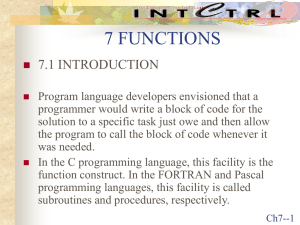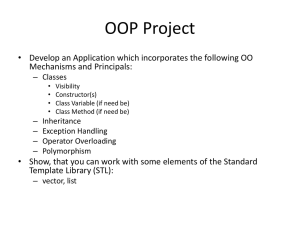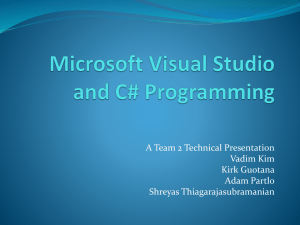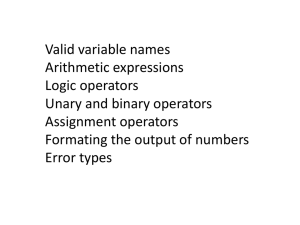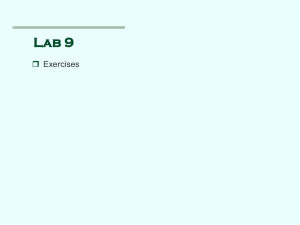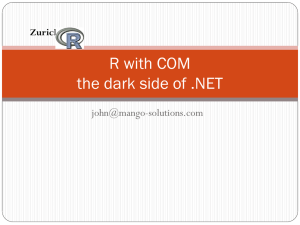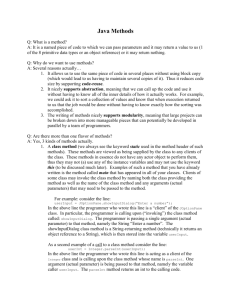Document
advertisement
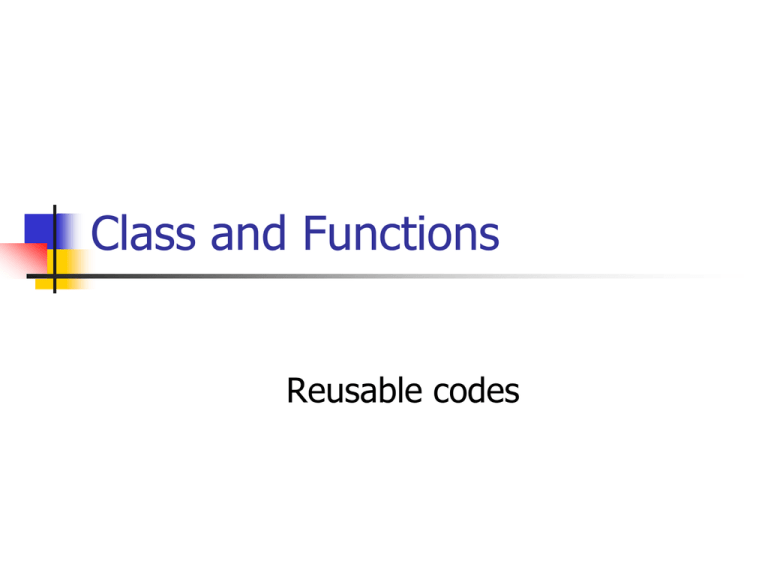
Class and Functions
Reusable codes
Object Oriented Design
First concept of object oriented programming is
emerged at 60‘s.
Smalltalk language which is introduced at 1972 was
first object oriented programming language.
Smalltalk has defined essentials and rules of object
oriented programming.
In 80’s C++ came out and made object oriented
programming a de-facto standard.
C# and Java programming languages which are
successors of C++, has widespread usage nowadays.
Object Oriented Design
Concepts and Design Process
OOP – Essential Concepts
OOP – Essential Concepts
OOP – Essential Concepts
OOP
Procedural Programming
Collection of interacting objects
List of subroutines
Data is private, accessed by using
methods
Data is global
Generally bugs are local
Bugs can span anywhere within a
program
Reusable objects
Reusable functions
OOP – Essential Concepts
They are the model of
real objects in software
Objects
Classes
They are the templates of the
objects.
Object Oriented
Design
Objects
Real World
Computer
Components that are
required to run a car:
Motor, wheels, steering
wheel, wiper etc. etc.
Classes
A class is a construct that has code and data
sections which are used for modeling real life
objects.
Makes programming modular.
Both code and data may reside in a class.
Modeling is the base of coding.
Object – Class ?
Class is a definition of an object. It is an
abstract concept.
Object is an instance of a class. It is a
quantity of concrete.
Example; Human class is a definition set but,
every one of us is an instance of Human
class.
Classes
• The basic function of
static void Main(string[] args)
Object
a class is defining
{
data and procedures
Car c = new Car(1999,"Honda");
that are used in an
if(c.getGear() != 0) {
object.
Class name/Type
c.changeGear(0);
}
• Class is a abstract
correspondence of an
c.startEngine();
object.
c.pushClutch(0);
c.changeGear(1);
• Abstraction is a
.....
fundamental element
.....
}
in OOP design.
Classes
Every C# class defines a new type.
Object is an instance of a class that
is created in memory.
Classes has interfaces and code
sections. Interfaces are accessible
functions and member variables,
code sections defines what can this
class do.
Design of interface is a critical
point.
Classes hide their data and
functionality by using “private”
keyword.
“public” defines interfaces.
public class Point
{
// private section
// restricts access to itself
private double x;
private double y;
// interface: accessible from
// any code
}
// procedure that finds distance
//from origin
public double getDistanceOrigin()
{
return Math.Pow(x*x+y*y,0.5);
}
Classes: Access control
Class name
Variables
within a
class
public class Point
{
// private section
// restricts access to itself
private double x;
private double y;
// interface: accessible from
// any code
Function
within a class
}
// procedure that finds distance
//from origin
public double getDistanceOrigin()
{
return Math.Pow(x*x+y*y,0.5);
}
Classes: Access control
private: where
internal data and
functions resides
public class Point
{
// private section
// restricts access to itself
private double x;
private double y;
// interface: accessible from
// any code
public: defines
interfaces (data
and functions) that
are accessible from
outside.
}
// procedure that finds distance
//from origin
public double getDistanceOrigin()
{
return Math.Pow(x*x+y*y,0.5);
}
Classes: Access control
In C# language there are three mostly used keywords that are used for
defining access levels to member variables and functions.
private: it is the section where internal member
variables and functions resides, is not accessible from
outside of the class.
public: it is the section where interfaces are defined.
Member variables and functions are accessible from
any other code.
protected: it is the section which includes member
variables and functions that can be accessible from
derived classes. It is not accessible from outside of
class.
Classes: Access control
• Default access level in a
class is private.
• If there is no explicit
access level keyword
then, access level is
implicitly defined as
private.
public class Point
{
// private section
// restricts access to itself
double x;
double y;
// interface: accessible from
// any code
}
// procedure that finds distance
//from origin
public double getDistanceOrigin()
{
return Math.Pow(x*x+y*y,0.5);
}
Structure of a C# program
public class Point {
double x,y,z;
public void distanceFromOrigin()
{
return ….;
}
}
Executable
program
+
public static void Main(string[] args)
{
Point n = new Point();
......
}
Classes: Usage
Lets define a Car class. There will be two public member variables named
Brand and Model and a public function class Run. Run function will
display some motor sound to the display.
Classes: Usage
If we want to use class Car first we should crate an object with type Car.
After definition we can call functions and set values to the member
variables in the interface.
Object
Class name
Value assignment
Function call
Exercise
Write a class named Human.
Properties
Name
Surname
Age
Create an object instance of the class and
assign values to it.
Print assigned values to the screen.
Classes - Functions
There are lots of functionality in OOP.
Encapsulation
Polymorphism
Inheritance
Before diving into these properties lets look
at functions
Functions
Functions are integrities of variables and
expressions that are used to fulfill a job.
They take definite parameter types and have
definite return types.
They can be called again and again from
other code sections of a program.
Basic definition:
return_type Funtion_name (Parameters)
Functions
Functions should
reside within a class.
We can not write a
function that is not
defined in a class.
public class MyClass
{
public void function()
{
do something;
}
}
Functions
We used just one function till now, which is;
static void Main(string[] args).
Notation:
static void Main(string[] args)
{
/* definitions
*/
/* expressions
*/
}
void keyword means that this function will not return a value.
Functions
() brackets implies that Main is a function.
Parameters that are meant to be send to
function will be written within these brackets.
In this example Main(string[] args) function
could take string[] type parameters.
Generally functions use parameter lists. They
perform and return output depending on the
values of these parameters.
Functions
We use a function in two steps. These
are;
Writing function itself (function definition +
statements within this function)
Statement that calls the function.
Function definition
There is no “;” after function definition
private float add(int a, int b, int c)
Here, function named add requires three
parameters named a, b and c. Function
returns a value with float type.
The values of variables a, b and c are
assigned by the statement which calls that
function.
Function definition
Function is composed of function definition, and statements
surrounded by curly brackets:
private float add( int a, int b, int c)
{
float t;
t = a + b + c ;
return t;
}
Note: Curly brackets determines stating and ending point of a
function.
Function definition
private float add( int a, int b, int c)
{
float t;
t = a + b + c ;
return t;
}
Variables a, b and c are valid only in function add.
Variable t which is defined in the function add is valid
only in the function and deleted after function execution
is finished.
Function definition
Functions use keyword return to return a result to calling. If
return type is void, then we don’t need to use keyword
return.
return keyword should return a value with a type that should
exactly match with the type defined in the function.
private float add( int a, int b, int c)
{
float t;
t = a + b + c ;
return t;
}
Function calls
Function definition should be taken into
account while calling a function.
Function parameters could be constants as
well as variables.
Usually the value returned from function is
assigned to a variable.
value = add( i, j, k );
or
value = add( 5, x, 2.7 );
Function call
When add function is called from main() function, the values that resides
in main() data section are copied to the data section of add() function.
main() data
section
add() data
section
i
12
j
25
k
45
copied
copied
copied
a
12
b
25
c
45
Exercise: Factorial Function
Write a class that has a function which
calculates the factorial of a given number. This
function will return 0 from numbers smaller than
zero and returns 1 for numbers 0 and 1.
Calculate the factorial of numbers by using a
loop for numbers greater than 1.
Write a main function that prints the factorials
of numbers between 1 and 10.
Remember that you should use the class and
function that we wrote in our program.
Exercise: Factorial Function
Class name
Function
name
Return type
Parameter
Exercise: Factorial Function
Object
Class name
Function call
Exercise
Write a function that takes two parameters
and returns the differences of factorials of
these two numbers.
Function prototype:
int factorial_difference(int a, int b)
This function may call the factorial()
function written before.
You may use the same class where
factorial() function is defined.
Exercise
Usage of this function will be;
Example
Write a function that swaps the values of its two parameters.
It seems that first output should be “5 3" and second one should be“3 5".
Example
a and b are local
variables which
are defined only
in the function.
Function can
not perform
swap operation.
Why it didn’t work?
Functions accepts two types of parameters.
value
Reference
By Value: Instead of actual parameters, copies of
parameter values are used while calling a function.
By Reference: Addresses of parameters are send
while calling a function. If function modified the
variable at this address, then the actual value is
modified (e.g. The main variable in main function)
Values - References
main() data
section
Value
Reference
i
12
swap() data
section
Copy of
parameter
main() data
seciton
&i
12
a
12
swap() data
section
Actual
&i
parameter
12
References
ref keyword is used for sending the actual
parameter itself to a funtion as a parameter.
In the function definition, you should put ref
keyword in front of the parameter which
meant to be used as reference parameter.
Similarly, ref keyword is used before
reference variable while function is called.
Example - Fix
Change the parameters of the function to reference type by adding ref
keyword in front of them.
Example - Fix
When we call the function with ref keywod, you will see that funcion is
working propely .
Classes: Constructor
Constructor functions are
called during creation of
object.
Constructor function and
classes have same names.
Constructors does not have a
return type (even void)
There can be multiple
constructors. Each should
have different parameters
(different signatures).
If there isn’t a constructor
defined, then default
constructor is used.
Classes: Constructor
There could be just one
parameterless default
contructor.
Constructor is called whan
an object is created with
new keyword.
Primitive types can be
created without using
contrutor and have
default values.
public static void Main(string[] args)
{
MyPoint p = new MyPoint();
......
}
Constructor
is called
Numeric (int,long…)
Bool
Char
Reference
->
->
->
->
0
false
’\0’
null
Classes: Constructor
While objects are created from classes, we should
use contrutors and their parameters.
MyPoint constructor
needs two
parameters.
Exercise
Write a MyTime class, with
• Two constructors
• A function that print time
• A function used for adding time
Use all methods of MyTime class in
Main function
Classes: Static Members
• Static members that are defined in a class can be accessed
without using an object instance of that class.
• Static members use only one memory location and one copy. A
value change from one code section will affect all following uses of
that member.
• Static members can be used for transferring data between objects.
• Static members defined by using static keyword.
Classes: Static Members
Assume that we are writing a computer game. In this game we are
modeling alien race named Martians. Martians attack if there are at least 3
Martians, else they do not dare to attack. Question is: How each martial will
know the number of Martians around?
Classes: Static Members
In addition of members, classes can
also have static functions.
Static method
Function is called
without using an object
Classes: Static Members
We don’t need objects to call static
functions.
ToInt32 function is called
without creating a Convert
object
Exercise
Write a class ConvertTemperature which
makes convertions between different
temperature units.
ConvertTemperature class will perform
conversion betwreen Celcius, Fahrenheit ve
Kelvin units.
Conversion functions should be static. In
other words we shouldn’t need an object to
make conversion.
Formulas:
Tc=(5/9)*(Tf-32)
Tc = Tk - 273.18
const and readonly members
C# language offers constant variables whose values
can not be changed.
We use const or readonly keywords to define
constant variables in a class.
We should assign values to const variables at the
definiton phase.
We should assign values to readonly variables at the
definiton phase or at the constructor of the class.
After these phases, we can not change values of
these const and readonly variables.
const and readonly members
Error!
Trying to change const
variable.
Enumerations
C# language has the feature of creating custom
types.
It increases the readability of the program code.
As an example, we can create an enumeration that
exists in a grub of people:
Enum Workers{ Laborer, Officer,
Director, Retired};


